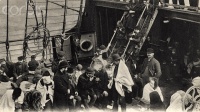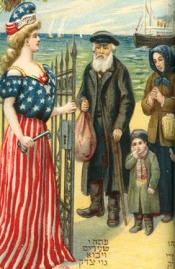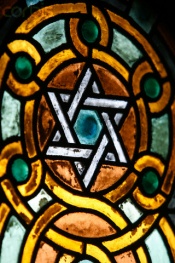From The Peopling of New York City
Introduction
"Millions would soon tear themselves away from the land that held the dust of their ancestors; millions would leave the "shtetlakh" and cities in which they had built their life, their Houses of Study and burial societies, their wooden synagogues and paintless houses, their feeble economy and thriving culture...The numberless ordinary Jews, the "folksmasn" for whom being a Jew was not an idea or a problem but the vibrant substance of their lives-now began to ready themselves. And not merely because their life in common was weak, but because as Jews they knew themselves to be strong"-Irving Howe from "World of Our Fathers"
History
Any history of the Jewish people would not be complete without mention of New York. Since the first Jews arrived in North America in 1654, until the present, New York has been a center of Jewish culture and life. For over three hundred years New York has been home to many Jews, and refuge for those fleeing from persecution. Whether from Spain, Eastern Europe, or Russia, there is something here for all Jews, and New York has become a home away from home for Jews awaiting the Ingathering of Exiles, when messiah will unite them all in Israel.
Class
The Jewish immigrant group, like most other immigrant groups faced struggles during the earliest periods of their immigration into New York City. Their residential patterns were restricted to tenement districts like the Lower East Side. Their occupations were also restricted to peddling, at first, and later on, the garment industry. These limitations fostered prejudice from older immigrant groups. Over time, through hard work and education, Jews progressed in education as well as occupational patterns. They have succeeded in professional occupations as well as scholarship.
- Residential Patterns of Jewish Immigrants to New York
- Occupational Patterns of Jewish Immigrants to New York
- Educational Patterns of Jewish Immigrants to New York
- Income of New York's Jewish Immigrants
- Health of New York's Jewish Immigrants
Culture
Jews, unlike most other immigrant groups, are defined by religion rather than place of origin. Consequently, Jewish culture is shaped mainly by needs and requirements of the religion. Family structures and other aspects of daily life are clearly defined in the Torah (Hebrew scriptures), which children are taught from a young age. In order to study Torah and pray, every religious Jew had to be able to read and understand Hebrew, which often was incorporated into common conversation. This gave rise to Yiddish, the hybrid language spoken by most European Jews, which remained the language of choice for Jews in New York for many years. The Lower East Side, the first home to most Jewish immigrants, had many Yiddish newspapers, storefronts, and theaters. As Jewish immigrants became more comfortable in America, the prevalence of Yiddish as a spoken language faded, and although some still speak it, English is the mameh loshen (mother tongue) of most American Jews today.
- Jewish Immigrant Family Structures
- Religious Practices of Jewish Immigrants
- Jewish Immigrants and Language
- Jewish Immigrant Entertainment
- Jewish Immigrants and Assimilation
The Bigger Picture
Although Jews comprise less than three percent of the American population, Jews have generally had a disproportionately larger representation in American government, business, academia, and entertainment. American Jews have suffered their share of setbacks and have had to combat anti-Semitism during the early twentieth century. On the whole, however, Jews have enjoyed greater acceptance in America than in any other country and have figured prominently in American culture and politics.



